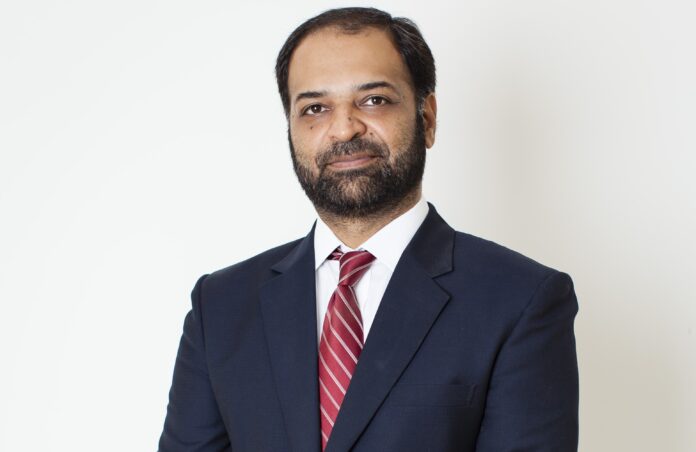The global value of the Islamic banking sector has been projected to reach $3.8 trillion in this year. What do you think is fuelling this growth?
The Islamic banking sector in the region has bounced back from the pandemic with increased resilience, thanks to higher oil prices and the recovery of the non-oil economy. Economies in the Middle East are faring well despite soaring energy prices globally. Also, the pandemic has accelerated the digital transformation of the sector, with innovation and increased automation enhancing the customer experience.
Alongside digitalisation, banks are continuing to develop robust environmental, social and governance (ESG) policies, conscious of their role in a more sustainable future. The size of the global Islamic finance industry is expected to grow exponentially and reach $5.9 trillion by 2026, driven by Islamic banks and sukuk, according to the 2022 Islamic Finance Development Index (IFDI) issued by Refinitiv, a subsidiary of the London Stock Exchange Group.[1]
NBF is strongly positioned to gain from the quality business opportunities presented through this positive market momentum.
How is the expansion of wealth management and private banking services affecting Sharia finance in the region?
Sharia finance is recognised for its sustainable and ethically responsible nature, with the growing demand for Sharia-compliant products boosting the share of Islamic assets globally. As Islamic finance grows, opportunities continue to emerge to expand financial markets, strengthen financial inclusion and create new funding sources.
For Shari’ah-compliant transactions, distributed ledger technology (DLT) is expected to reduce transaction costs, help in tokenisation of assets and contribute to the transparency of transactions. DLT can also help to speed up the transfer of Shari’ah-compliant assets, by mobilising funds from investors.
Will the volume of Sukuk issuance increase or decrease in the next two years?
Recent economic and geopolitical developments have only had a muted impact on sukuk markets. Issuance eventually slowed on the back of two trends: multiple interest rate hikes by the Federal Reserve and other central banks, and persistently high oil prices. Over the course of 2022-2023, S&P Global Ratings forecasts the Shariah-compliant lending sector to grow by another 10 percent.[2]
According to Moody’s, Global sukuk issuance this year is forecast to “level off” in the range of $170 billion to $175 billion in 2023, supported by sovereign financing needs in key Asian markets of Malaysia and Indonesia and resilient demand from banking and corporate sectors. The levelling off of sukuk volumes follows a 10 percent fall in 2022 to $178 billion given lower funding requirements from the six-member economic bloc of GCC region and South-east Asian markets.[3]
Egypt has begun the sale of its first Islamic debt issuance, reportedly attracting strong demand. Global sukuk is projected to grow at a compound annual growth rate of 6.8 percent over the next five years and Sukuk issuance is projected to reach $257 billion in 2027, with nearly 41 percent of respondents in a recent Refinitiv survey saying they were still bullish about growth in sukuk supply.[4]
How is Islamic Banking in the region adapting to the rapid and widespread integration of technology and innovation in finance?
Digital banking solutions are significantly advancing banking activity in the UAE, enhancing the customer experience with reduced transaction costs. Modernising the technology infrastructure to meet service demands has enabled a safe and dynamic environment, with specialised services such as cloud computing driving innovation. With more than 95 percent of all transactions by the UAE’s leading banks now taking place digitally, investments into digital capabilities are ensuring that smartphones in particular can safely and conveniently manage account data.[5]
Digitisation is helping banks to reduce operating expenses, by streamlining and automation of internal processes, as well as cutting the costs of acquiring and serving customers. Global rating agency Moody’s expects digitisation to accelerate among Islamic banks, helping these banks expand at lower cost. Another benefit of digitisation, particularly for banks with a small physical presence, is improved access to the public, which can also help to boost revenue.
How do you see the role of Islamic finance developing both regionally and globally in the coming five years?
At the macroeconomic level, higher commodity prices (particularly for hydrocarbons and palm oil) are expected to underpin a stronger recovery in major Islamic finance markets such as the Gulf states, Malaysia and Indonesia. Moreover, inflation in these countries will also remain moderate because of government subsidies and interest rate hikes.
The outlook is also positive for the Islamic banking sector. Financing to public-sector employees, who enjoyed stable employment during the pandemic, constitutes the lion’s share of retail financing in the GCC region. This focus on retail financing, plus prudent underwriting and the development of strong provisioning buffers, mean that the return on average assets of Islamic banks looks set to improve. Profitability will be further driven up thanks to efficiency gains from digitalisation, as well as rising interest rates, particularly in the Gulf states where domestic currencies are pegged to the US dollar.
Looking ahead, NBF will continue to look for new quality business opportunities, keeping in view the booming oil sector which will drive the acceleration in economic growth of the UAE, while a strong non-oil sector will add further impetus thanks to the government’s strategy to diversify and grow the economy.











